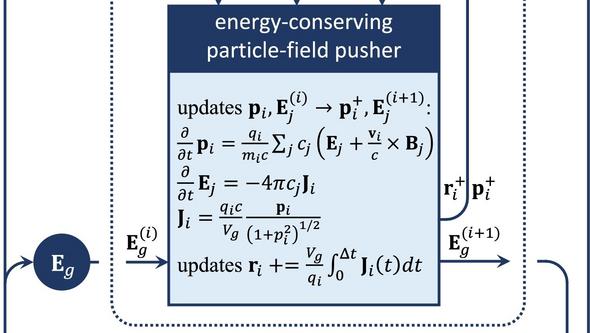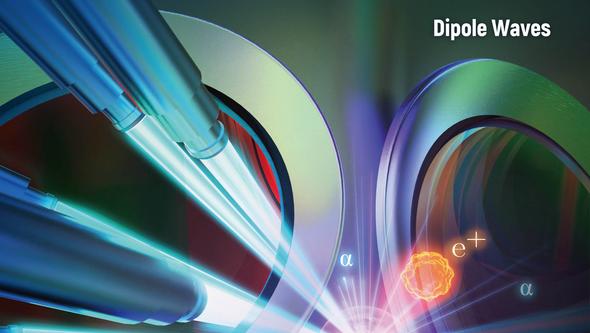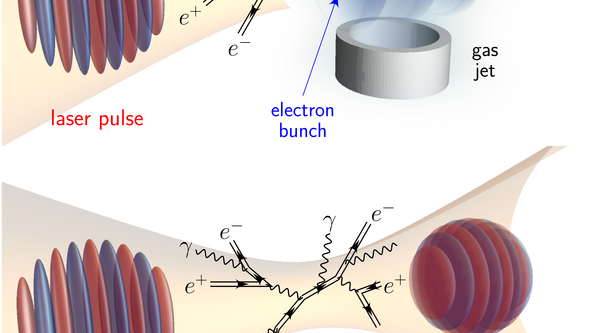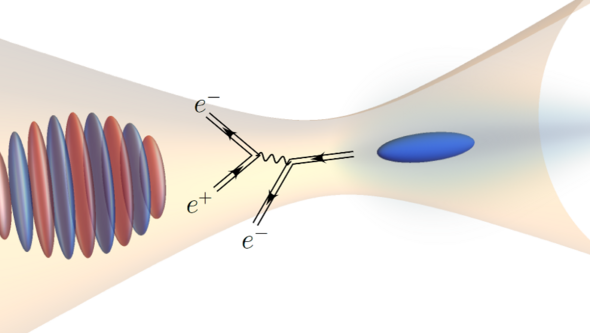
Plasma physics
Short description
Ultraintense lasers, electron and ion acceleration, avalanches of electron-positron pair production, and breakdown of the vacuum itself. All of these and more are topics of interest in the plasma physics group. We use theory and simulations to investigate the dynamics of plasmas found in the most extreme environments in the Universe. We want to find strategies to identify these dynamics in experiments, and how they can be harnessed to create particle and radiation sources with desirable properties.
Exact energy conservation in PIC codes
This article presents a new energy-conserving, explicit approach that is capable of reducing computational demands by orders of magnitude and thereby promises to accelerate numerical studies in many areas of plasma physics.
Reference: A. Gonoskov, Explicit energy-conserving modification of relativistic PIC method, J. Comput. Phys., 502, 112820 (2024), arXiv:2302.01893

Signals of strong-field QED from noisy data
How do we extract meaningful signals of strong-field quantum electrodynamics (SFQED) from noisy collision data? This occurs for many reasons: quantum processes are naturally probabilistic; signals that reach the detector will be masked by interactions that originate from lower energy; misalignments and fluctuations mean that the obtained data varies between collisions.
One way to mitigate these problems is to obtain many data points for less extreme conditions and look for SFQED processes using Bayesian statistics. In this paper, we highlight the use of a specific technique called approximate Bayesian computation (ABC). ABC compares the outcome of experimental data to that of simulated data to assess how well one physical model describes reality. Here, the ABC routine is applied to a certain model that describes an SFQED effect called the effective electron mass. This enables us to probe how well such a model would match with experimental data that is susceptible to uncontrolled fluctuations.
Reference: C. Olofsson and A. Gonoskov, Prospects for statistical tests of strong-field quantum electrodynamics with high-intensity lasers, High Power Laser Sci. Eng. 11, e67 (2023), arXiv:2303.00568

Towards critical and supercritical fields
High-power lasers already allow us to create some of the strongest electromagnetic fields in the universe. The question is: how far will we be able to go with future laser systems? Can we create electromagnetic fields as strong as, or even stronger than, the critical Schwinger field? And what kinds of physics would it be possible to probe with these fields?
In this paper, featured on the cover of High Power Laser Science and Engineering, we describe a scheme in which multiple pulses of laser light, converted from optical to extreme ultraviolet (XUV) wavelengths by plasma targets, are focused to a single point, creating an electromagnetic field strong enough to disrupt the internal dynamics of nuclei, and to create matter from the quantum vacuum. Advanced numerical simulations show that it is possible to reach a field strength ten times greater than the Schwinger field for a total laser power of 20 PW. While realising such a scheme poses immense engineering challenges, it affords an exciting opportunity to investigate the behaviour of electrons, nuclei and the quantum vacuum under the most extreme conditions.
Reference: M. Marklund, T. G. Blackburn, A. Gonoskov, J. Magnusson, S. S. Bulanov and A. Ilderton, Towards critical and supercritical electromagnetic fields, High Power Laser Sci. Eng. 11, e19 (2023), arXiv:2209.11720

Laser-plasma interactions at high intensity, reviewed
Ultra-strong electromagnetic fields occur not only in astrophysical settings but also in dense lepton bunches, special crystals, and at the focus of high peak power lasers. For fields of sufficient magnitude including quantum electrodynamics effects becomes essential. Electron-positron pair creation and interaction of these pairs with the fields results in fascinating phenomena. In this review these particle dynamics are analysed and shown to exhibit complex behaviour including chaotic motion with strange attractors and limit cycles, as well as cascades where the vacuum “explodes” and acts back on the strong fields. An overview of planned experiments points to new discoveries which will challenge long-held theoretical expectations.
Reference: A. Gonoskov, T. G. Blackburn, M. Marklund and S. S. Bulanov, Charged particle motion and radiation in strong electromagnetic fields, Rev. Mod. Phys. 94, 045001 (2022), arXiv:2107.02161

Ptarmigan
Ptarmigan is a Monte Carlo, particle-tracking code that simulates the interaction of high-energy electrons and photons with high-intensity laser pulses, encompassing both the classical dynamics and strong-field QED processes. Uniquely for codes of this kind, Ptarmigan includes fully angularly resolved emission and pair-creation rates. Choose between the standard locally constant field approximation (LCFA) or the more accurate locally monochromatic approximation (LMA), quantum or classical dynamics, and from a variety of collision parameters [1]. The code is under active development and hosted on Github [2].
References:
[1] T. G. Blackburn, B. King and S. Tang, Simulations of laser-driven strong-field QED with Ptarmigan: Resolving wavelength-scale interference and γ-ray polarization, Phys. Plasmas 30, 093903 (2023), arXiv:2305.13061
[2] Ptarmigan, https://github.com/tgblackburn/ptarmigan

𝜋-PIC
𝜋-PIC is a python library that offers particle-in-cell solvers featuring exact energy conservation (for explicit methods) and the absence of numerical dispersion [1]. These properties provide a way to either suppress or eliminate numerical artifacts (instabilities, heating, dispersion, etc.), allowing one to achieve similar accuracy with larger space and time steps, as well as smaller number of particles per cell. Because of reduced computational demands, the solvers can be useful for quickly testing ideas and scanning parameter spaces. The library makes it possible for users to develop and contribute Python/C/C++ extensions. The current toolbox includes, among others, state-of-the-art extensions for QED event generation [2] and ensemble down-sampling [3]. The project and its development are hosted on GitHub [4].
References:
[1] A. Gonoskov, J. Comput. Phys., 502, 112820 (2024), arXiv:2302.01893
[2] V. Volokitin et al, J. Comput. Sci. 74, 102170 (2023), arXiv:2303.00648
[3] A. Gonoskov, Comput. Phys. Commun. 271,108200 (2022), arXiv:1607.03755
[4] 𝜋-PIC, https://github.com/hi-chi/pipic
